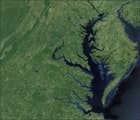President Barack Obama signed an executive order today creating a Federal Leadership Committee for the Chesapeake Bay to be chaired by the U.S. Environmental Protection Agency (EPA). The executive order calls for EPA and six other federal agencies to coordinate and expand federal tools and resources to help speed cleanup of the nation’s largest estuary.
At a meeting of the Chesapeake Bay Program Executive Council at Mount Vernon, Va., EPA Administrator Lisa P. Jackson presented the executive order, which creates the Federal Leadership Committee for the Chesapeake Bay. The committee will be chaired by EPA and will manage new plans by a team of seven federal agencies to strengthen and bring accountability to efforts to protect and restore the bay.
In addition to the executive order, Jackson announced that EPA’s renewed commitment to bay restoration will include a bay-wide set of strict pollution caps backed by state action plans and federal consequences to assure progress; sharp reductions in air pollutants that impact the bay; robust use of existing authorities; key funding support, and unrivaled scientific and technical assistance.
“This executive order is a strong signal of the President’s commitment to restoring this national treasure, which is so vital to the environment, the local economies and the way of life for millions of people,” said Jackson. “We are bringing the full weight of this partnership to bear on this challenge, and I am extraordinarily hopeful about what we can accomplish working together.”
Federal agencies will create action reports that will be integrated into a draft federal strategy within 180 days of the signing of the executive order. The federal strategy will include annual commitments and progress reports and periodic reviews by an independent evaluator.
For its part, EPA’s plan will identify actions to make full use of Clean Water Act tools, including strengthening existing permit programs and extending coverage where necessary. The agency also will implement a compliance and enforcement strategy to ensure that regulated entities follow the rule of law.
EPA is also working with its state partners to develop a bay-wide total maximum daily load (TMDL) by December 2010 that will assign strict pollution caps to meet the state’s existing Chesapeake Bay water quality standards.
The TMDL will identify the total pollution caps necessary to meet clean water standards and allocate pollution budgets to the states. Those allocations will be used to develop detailed state action plans that will be supported by two-year commitments and strong accountability provisions with federal consequences for lagging performance.
The TMDL process will involve strong public participation, including a first round of public meetings this summer.
EPA will also build on a range of actions to reduce air pollution that impacts the bay, including a new Clean Air Interstate Rule that will provide significant reductions in nitrogen and other pollutants emitted from power plants and other sources in the eastern United States. CAIR is expected to reduce nitrogen loadings to the bay by an estimated 10 million pounds annually beginning in 2010.
Through American Recovery and Reinvestment Act of 2009 commitments and a record budget request, EPA will finance projects throughout the watershed to advance restoration of the bay. States in the watershed have begun to approve Clean Water State Revolving Fund awards from the recovery act to reduce water pollution impacting the bay and its tributaries.
Last week’s $35.1-million budget proposal for the Chesapeake Bay Program for fiscal year 2010 is the largest ever requested by an administration.
EPA’s Chesapeake Bay Program will continue to provide unrivaled scientific and technical assistance to help meet the challenges and opportunities in the watershed.
More information on the Chesapeake Bay Program is available at: www.epa.gov/Region3/chesapeake/.
Source: EPA


